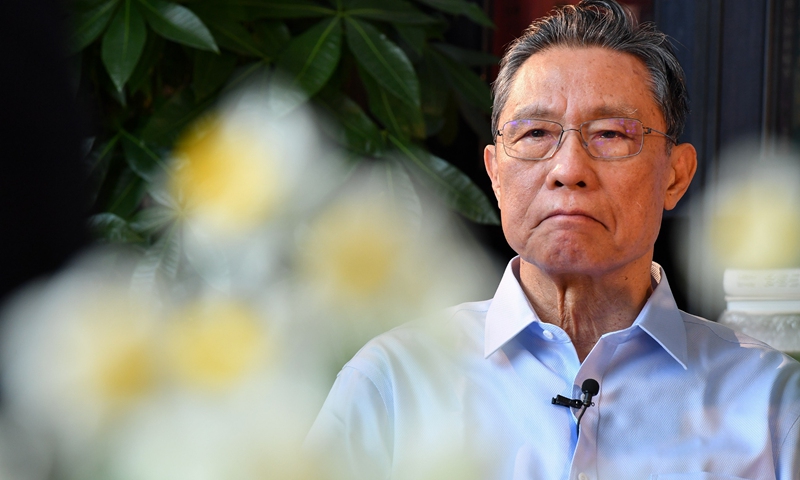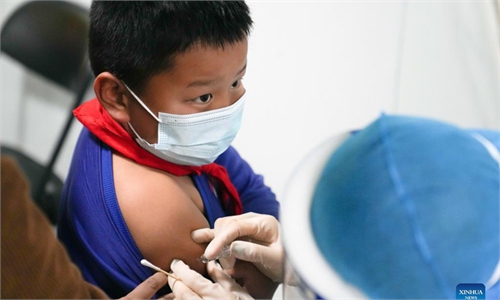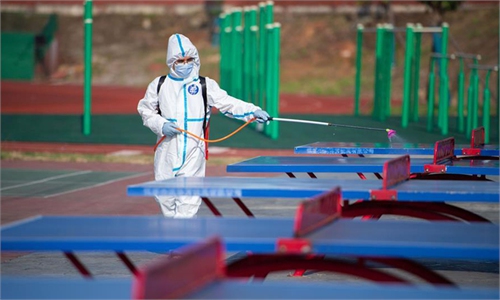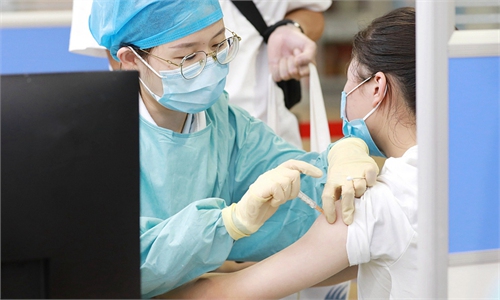Omicron not scary, as 99% of those infected can fully recover in 7-10 days: Zhong Nanshan

Zhong Nanshan Photo: Xinhua
Omicron is not scary, as about 99 percent of those infected with Omicron can fully recover within seven to 10 days, and the focus should be put on preventing severe illness caused by the virus, China's top respiratory disease expert Zhong Nanshan said at a national academic video conference of respiratory diseases held on Friday.
Zhong delivered a speech on the Omicron epidemic situation and response and affirmed the achievements made in epidemic prevention and control over the past two years, according to the People's Daily.
The second wave of Omicron outbreaks across the country spread fast, and the risk of "sequelae" caused by Omicron has been significantly reduced compared with the Delta strain, and asymptomatic carriers were basically free of COVID-19 sequelae, Zhong said.
The post-recovery problem is actually affected partly by social psychology currently, which still needs to be observed further from strict clinical perspective, and we should view it objectively, Zhong said at the conference of respiratory diseases on Friday, chinanews.com reported via its Weibo account.
In an interview with China Central Television, Zhong said that there is a strict medical definition of sequelae, which means that the damage caused by the disease lasts for a lifetime. Zhong doesn't think there is a serious post-recovery problem caused by COVID-19. The syndromes such as depression, anxiety and insomnia will gradually disappear after recovery. We don't call these syndromes sequelae, he said.
The focus of prevention and control policies should shift to severe illness and better implementation of the newly released 10 measures by the State Council, said Zhong. He also mentioned that adequate vaccination could provide effective protection.
Next we should strengthen vaccination, Zhong said, noting xenogeneic vaccination could enhance effectiveness. The country should focus on strengthening the immunization of the elderly and vulnerable groups and strengthen vaccine protection for medical staff, as well as accelerate the development and approval of nasal spray and inhalation vaccines, Zhong noted, according to the report.
As of November 28, 2022, China's confirmed COVID-19 cases ratio is 1/374 of the global average, or 1/1,348 of the US', and the death rate is 1/232 of the global average, according to Zhong, Jiankang Shibao reported on Friday.
In a report released in May 2021, the World Health Organization described the prevention and control strategies adopted by four different countries in the world and their effects, and listed China's as the best option, Zhong said.
Renowned Chinese epidemiologist Li Lanjuan also echoed the opinion that there is no need to panic over Omicron. Asymptomatic infection is not a disease, and a silent carrier is not a patient, Li told the Jiankang Shibao.
Although an asymptomatic carrier is contagious, the person is not a patient and there is no need to panic, said Li. Asymptomatic infection is called "recessive infection," which is the most common manifestation in most infectious diseases, and the number of asymptomatic infection often far exceeds that of symptomatic infection. Asymptomatic infection is not a disease, as most people can obtain different degrees of specific immunity, according to Li.
China's adjustment on epidemic prevention and control is "a correct decision based on scientific research," Li said. The incidence rate of infectious diseases is often very high in the initial stage, and people are also susceptible to the virus, which can easily lead to severe infection. In the early stage of the epidemic, the country conducted measures including strict testing screening, quarantine, cutting off the transmission chain, and treating every patient at all costs, which effectively controlled the epidemic and ensured people's health, according to Li.
According to data released by Singapore, the case fatality rate of the Omicron variant in the epidemic period from January to November this year was 0.45‰ in Singapore, much lower than the 3.6‰ case fatality rate of the Delta variant in the period from June 2021 to January 2022.
Li said that the virus will continue to mutate as it spreads naturally in the future, adding that we also need to follow closely the virus mutation, and study the relationship between the virus mutation and virulence.
Zhong said that the COVID-19 epidemic is not over yet, but he stressed that the pathogenicity of the Omicron variant has been greatly reduced. "As for correctly evaluating the epidemic situation caused by Omicron, we cannot completely use the same method of two years ago," he said in an opening speech for a national academic conference on respiratory diseases on Thursday night. "The virus has become extremely infectious, but the pathogenicity has been greatly reduced."
Zhong also called on respiratory physicians and researchers to take responsibility for helping optimize national policies so that the country can "prevent the epidemic, stabilize the economy, and secure development."
China has adjusted and optimized its COVID-19 response in the past few days, including allowing asymptomatic carriers and patients with mild symptoms and those who meet certain requirements to quarantine at home. This led to certain concerns among the public about whether the risk of infection might be higher than before.
According to media reports, the average daily sales of COVID-19 antigen self-testing kits have increased more than 400 times compared to November.
The Chinese mainland on Thursday reported 3,588 locally transmitted confirmed COVID-19 cases and 13,004 asymptomatic carriers, the National Health Commission said Friday.



